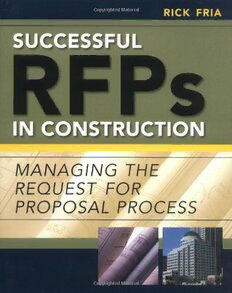
Successful RFPs in Construction: Managing the Request for Proposal Process PDF
192 Pages·2005·0.927 MB·English
Most books are stored in the elastic cloud where traffic is expensive. For this reason, we have a limit on daily download.
Preview Successful RFPs in Construction: Managing the Request for Proposal Process
Description:
The negotiated contract method for RFPs is a rapidly growing trend in construction. Traditionally, RFPs have gone through a competitive bid method – meaning that 100% of the design work is done without the input of contractors and with very little real cost information. With the negotiated contract method, only about 10% of the design work is done before a contractor is brought to the table, which means less paperwork and lower up-front costs. There are several advantages to the negotiated contract method: •Because only a small part of the design work is done up-front (before a contractor is brought on board), no extensive re-design work has to be done when budget/schedule issues with the design become a factor. •A complete team – architect/designer and contractor – is assembled earlier, making for a much more efficient process and outcome. •The RFP process becomes a collaborative effort, rather than a competitive one. There is no other book on the shelf that either focuses specifically on RFPs in the construction industry, or features a step-by-step method for implementing the negotiated contract method. This is a step-by-step guide for managing the RFP process in a way that saves time, money, enhances team collaboration, and assures quality in construction. Focusing on the negotiated contract method (as opposed to the competitive bid method), the book takes readers from articulating the needs/wish list for a construction project, to the analysis of responses and interviews, through negotiations and finalization of the deal. This is a roadmap for: •Preparing, understanding, and assessing the quality of information in an RFP. •Gathering critical, project-specific information from free and up-to-date local databases. •Adding value to the process by assisting consultants in marketing and project management capabilities. •Selecting and working with a team early in the process to stay on-schedule and on-budget. •Improving the materials selection process and the end-result overall quality of construction. •Example and template forms make it easy to create a successful RFP process.
See more
The list of books you might like
Most books are stored in the elastic cloud where traffic is expensive. For this reason, we have a limit on daily download.
